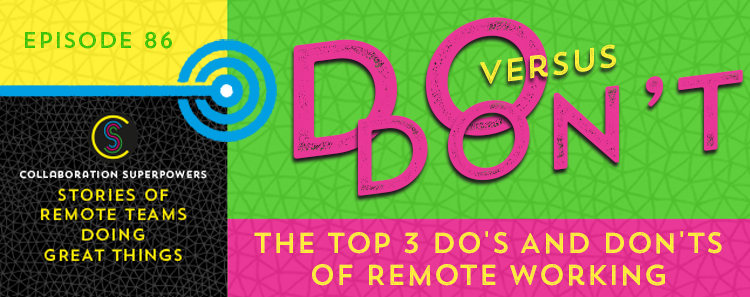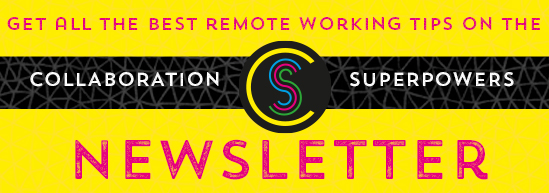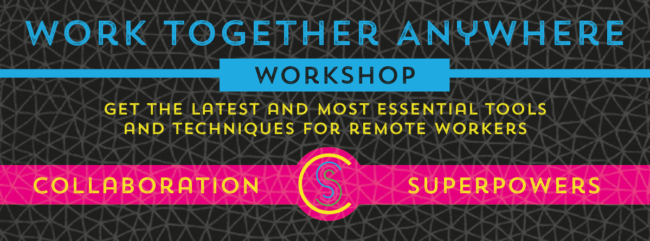
Inspired by something Tim Ferriss did on his podcast, this episode focuses on distilling remote work down to its essentials. I went through a huge list of ideas and came up with what I think are the essential things that make remote work… or not.
Subscribe to the Collaboration Superpowers Podcast on iTunes, Stitcher or Spotify.
Top do’s of remote working
- Have great internet and use great equipment. If you don’t have great internet, you’re doomed. Invest in a decent (and comfortable) headset. Get a second monitor. Make sure you have a webcam
- Embrace video. We lose so much information by not being able to see each other. Facial expressions play a major role in communication. Many people don’t like turning their videos on. But get over it. Be a professional. And turn those webcams on!
- Work out loud. Find a way to be visible with your teammates so you know what each other are doing. Be a pro-active communicator.
Top don’ts of remote working
- Don’t be hard to find. Create a team agreement about how you want to work together and stick to it.
- Don’t break your promises. Reliability is a huge factor in building trust on remote teams.
- Don’t let things fester. When something is bothering you, don’t wait too long to say something. Create regular check in points to communicate well with your team.
Podcast production by Podcast Monster
Graphic design by Alfred Boland
Original transcript
Welcome to the Collaboration Superpowers podcast. My name is Lisette and I’m interviewing people and companies doing great things remotely. Hello, everyone, and welcome to episode 86. Today, finally, we are going to discuss the top do’s and don’ts of remote working. If you’ve been listening to this podcast for the last few weeks, you’ve heard me say next week we’re going to talk about the do’s and don’ts, and then I get distracted by a shiny, new remote team that I’ve just [inaudible – 00:36] interview. But this week we’re finally going to get to it.
We’re right in the middle of the seasons changing in the Netherlands to spring. And the birds are going crazy, so you’ll probably be able to hear birds chirping if you listen closely. Also, the neighbor kids who’ve just gotten home from school and they are discovering musical instruments. So this episode is going to have an odd soundtrack.
Okay, but back on subject, so I got the idea for the top do’s and don’ts from of course listening to the Timothy Ferriss podcast. And people who know me know that I’m a big fan of that show. He did an episode where he was trying to distill the top three things about a particular subject. And it got me wondering what the top three do’s and don’ts would be for remote working. So I set off and I made a list of all the things that I thought were really important to do and then all the things that I thought were really important not to do. And then came the hard part which was distilling it down to oh, my gosh, what would be the top three in each of these long lists. But I forced myself to do it. And actually, I think when I look at my list and the top threes that I’ve chosen, I feel pretty confident about what I’ve chosen. So I’m excited to share that with you today.
We’re going to first start with the do’s, and I have to say that my top two picks under things we absolutely need to do in remote working are going to seem very, very simple. But I’ve done enough workshops now and I’ve seen it often enough that while it is simple, many people are not executing on the simplicity. So that’s why it’s going to be my advice.
The first top do of remote working is to have great Internet and use great equipment. It sounds very simple but many places still don’t have great Internet connections, or many people are just not willing to pay for them. I can’t tell you the number of times I’ve heard people say I prefer to work from home because my Internet connection at home is much better than the one that we have at work. And I’ve been to enough companies now where I’ve seen the equipment that they’re using. And it’s a bit shocking how old some of the equipment is and some of the regulations and rules that are forced on the employees.
Now in terms of equipment, I’m not talking about gold-plated computers and really fancy things. What I mean by having good equipment is having a noise-cancelling headset. It makes all the difference both for the person listening to you and for you listening and have a webcam.
This brings me to my second do of remote working, and that is embrace video. Turn those video cameras on. We lose so much information by not being able to see each other. It’s just not worth it. If you have the ability and you have the bandwidth, then just turn the video camera on. Many people say, “Oh, I feel shy because I’m sitting at home in my pajamas.” What I would say is if we have to go into the office, we also have to look professional. So put on a nice shirt and turn your video camera on and make it happen. The tools in the video department have come a long way in the last five years, and they are a lot less painful than they used to be. If you’ve listened to this podcast, I’ve gone on and on and on about this before. So I won’t do it now, but that is my second do of remote working. Turn the videos on.
And my third top do of remote working is work out loud. I think on any team, it’s important to be a proactive communicator. But on a remote team, it becomes an essential practice. Having people who are shy about reaching out and wanting to say something will just make the remote communication much more difficult. You really want people who are eager to reach out and won’t hesitate to pick up the phone or make a video call or whatever it is that needs to be done. So that’s one form of working out loud. But really, what working out loud is all about is finding a way to be visible with each other on our teams and making our work visible to each other so that we know what each other are doing when we need to know. I’m so tempted to go through the rest of my list, but we’re going to keep it at the top three do’s of remote working. So that was have great Internet and great equipment, embrace video, and work out loud.
Now let’s move on to the don’ts. My first don’t of remote working, the top don’t is don’t be hard to find. If you’re working with a team of people, create a team agreement about how you want to work together, and then stick to that and stick to the things that you guys agreed on. If someone sends you an email, don’t wait too long to respond. Different people have different response times, but we all know about what’s reasonable.
The second don’t of remote working is don’t break your promises. If you say you’re going to do something, then either do it or let people know that you’re not able to do it. Both of those things are good communication practices. Essentially, what I’m saying is be reliable. Reliability is a huge factor for building trust on remote teams. So if you’re going to focus on anything, focus on that.
My third don’t of remote working is don’t let things fester. When something is bothering you, don’t wait too long to say something because even the smallest of frustrations build up over time and sometimes to the point of no return. So what we want to do is create regular check-in points where we’re always talking to each other and thinking about how we can improve. And when we let things fester, problems seem to grow bigger than what they actually are.
So my top three don’ts of remote working was don’t be hard to find, don’t break your promises, and don’t let things fester. I hope you enjoyed this episode, everyone. It was short, sweet, and to the point, which is the whole point of the top three do’s and don’ts of remote working. If there’s anything you want to add or if you have a story to tell, then get in touch. You can find me at collaborationsuperpowers.com. Stay tuned next week for a very special interview with Johanna Rothman. She’s a management consultant for software managers and leaders and the author of many, many books. I had book-writing envy when I saw how many books she’s written. She’s a real joy to talk to. And if you’re really interested in distributed Agile teams, Johanna Rothman is definitely on the list of people that you want to ask. So stay tuned for that one.
Our weekly thanks for the amazing and innovative Nick, the podcast monster. He really keeps this podcast shining. You can hire him to make you a star at podcastmonster.com. All right, everybody, until next week, be powerful.




Good lists, well presented. Now I am 100% remote working, I can say I agree 100%.
Thanks Lisa. I appreciate hearing that. And thank you for listening to the podcast 🙂
Thank you, Lisette. You can never, ever emphasis the need of good internet connection and great equipment too much. Or put it the other way around: a bad connection and/or bad equipment will kill all possibilities of having good communication and team spirit.